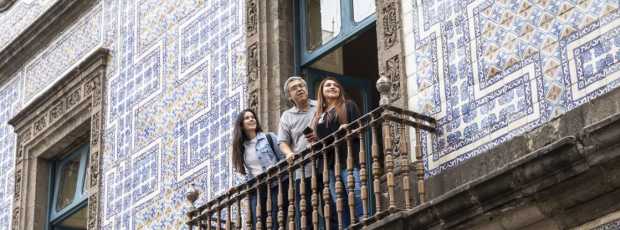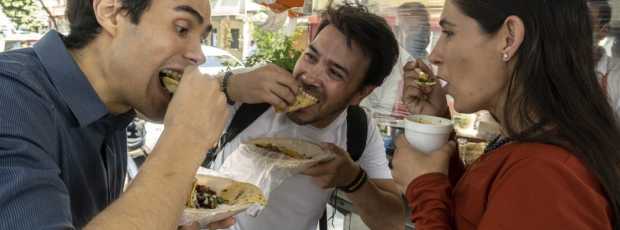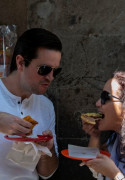Such a beautiful way to see the neighbourhoods with a personalized local tour that showed architecture, historical buildings and local hot spots.Shamli, Mexico City, 2025
Taste Mexico City’s real flavors on a private food tour
Eat where locals actually go
Table Of Contents
- Which Signature Dishes and Local Classics Should You Try?
- Best Places to Eat All This Food in Mexico City
- Foodie Neighborhoods
- Nightlife and Bars
- Authentic Food Markets
- Hidden Gems
- Stereotypes and Reality
- Overhyped → Local Alternatives
- Everyday Rituals and Time-of-Day
- Seasonal Food Culture
- Old vs New Identity
- Etiquette and Local Rules
- Interest-Based Eating
- Global Food Scene
- Frequently Asked Questions
- Final Thoughts
I'm Sofía, born in Puebla but chilanga by choice for eight years now. I've spent those years eating my way through every colonia in this city, from 6 AM tamale carts in Centro to 1 AM pastor lines in Narvarte.
What started as homesickness for Puebla's food scene turned into an obsession with Mexico City's rhythm-driven eating culture.
Three months into living here, I made the classic mistake of showing up to El Vilsito at 8 PM for tacos al pastor.
The trompo wasn't even spinning. An older woman in line behind me laughed and said, "Mija, pastor starts at 10 PM. Come back when the city's hungry." That night changed everything. I stopped eating like a tourist and started following local timing.
I've hosted casual food walks for friends, family, and curious travelers who want to eat like chilangos, not chase Instagram shots. I sometimes host with City Unscripted for folks who want the timing right.
This Mexican food guide maps what to eat in Mexico City by the city's own clock, not yours.
Follow me for a unique and memorable Mexico City experience. You'll start with masa at dawn and end with pastor past midnight, swapping tourist traps for timing tricks.
Want to Experience Mexico City Firsthand?
Step into the Mexican neighborhood, scene, or story with someone who knows it inside out.
Which Signature Dishes and Local Classics Should You Try?
I don't rank foods by popularity. I rank them by when the city actually eats them and where the lines tell you to show up.

Tamales Oaxaqueños with mole sauce and chicken
Tamales Oaxaqueños
Banana-leaf wrapped, stuffed with mole sauce, chicken, or cheese; dawn staple that sells out by 8 AM.
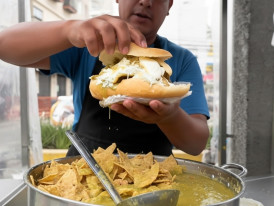
Guajolota - bolillo roll stuffed with a tamal and chilaquiles
Guajolota + Atole
Tamal stuffed into a bolillo roll with hot atole on the side, pure commuter breakfast fuel at metro exits from 6 to 9 AM.
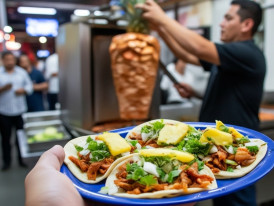
tacos al pastor
Tacos Al Pastor
Trompo-grilled pork with pineapple, Mexico City's late-night signature and unofficial nightcap.

Tacos de suadero
Suadero
The most chilango taco, supple beef from the griddle that's been simmering all day, then crisped to order. Best after 9 PM when the griddle's properly seasoned.
Forget hotel breakfast when visiting Mexico City. That's just not how you'll get a truly authentic street food or even basic Mexican food experience.

Blue maize tlacoyo with green salsa
Tlacoyos
Pre-Hispanic blue corn masa pockets stuffed with beans or requesón, topped with cooked cactus (nopales), green salsa, and crumbled cheese.

Pouring salsa on a fried quesadilla
Quesadillas
Fresh comal-made with corn tortilla, but may not include cheese unless you specify con queso.
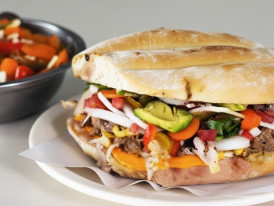
Torta cubana and chiles Jalapeños
Tortas
Mexico City's commuter sandwich culture, fat bolillos stuffed with everything from milanesa to pierna to carnitas. Quick, filling, and eaten standing at counters citywide.
Imagine Having a Friend in Mexico City
Our locals share their city with you the way they live it: flexible, real, and unscripted.
See how it works
Barbacoa from El Hidalguense
Barbacoa and Consomé
Sunday morning ritual, pit-roasted lamb with rich broth, garbanzos, and lime juice.

Tacos de carnitas
Carnitas
Weekend mercado staple, order by the cut (maciza, buche, surtida), best before noon when the pork's still glistening from its lard bath.
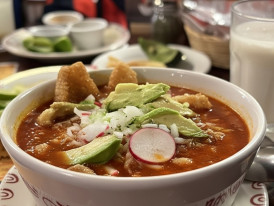
Pozole Rojo
Pozole
Weekend hominy soup, red or white, topped with lettuce, radishes, oregano, and lime juice; families gather for conversations that stretch all afternoon.
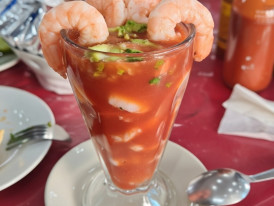
Coctel de camarones (Shrimp cocktail)
Mariscos CDMX-Style
Seafood at stands serving caldo de camarón, cocteles, and ceviches. Daytime eating, best at lunch when the trucks have just arrived from Veracruz.

Churros and hot chocolate
Churros and Mexican Hot Chocolate
Hot oil, fresh dough, cinnamon sugar, and thick cacao that coats your spoon.
What If Your Next City Day Didn’t Come From a Guidebook?
Instead of following a script, we connect you with someone who lives there and knows the places worth your time.
Guava roll from Panadería Rosetta
Guava Roll
French technique meets Mexican flavors at Panadería Rosetta; flaky pastry wrapped around guava paste that tastes like childhood.

Chile en Nogada from El Cardenal
Chiles en Nogada (Seasonal)
September independence dish, poblanos stuffed with fruit and meat, covered in walnut cream and pomegranate seeds.

Pan de muerto
Pan de Muerto (Seasonal)
November orange-scented bread with bone-shaped decorations for Day of the Dead festivities.
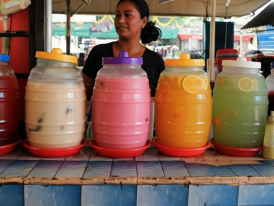
Aguas Frescas stand (fruit waters)
Agua Fresca and Pulque
Cooling fruit waters (horchata, jamaica, tamarindo) and funky fermented agave that tastes sour until you crave it.

Café de olla and sweet concha bread
Café de Olla
Coffee brewed in clay pots with cinnamon and piloncillo; the ritual adds soul to morning routines.
Hungry to Try Mexico City's Food Yourself?
Taste and explore the flavors locals actually love.
Best Places to Eat All This Food in Mexico City
These are the spots I take visitors who want to skip the research phase and eat well immediately. Some I've been going to for years, some I discovered last month, all of them pass the local approval test.
Tacos Al Pastor
Pastor isn't breakfast food, it isn't lunch food, it's what happens when the city finally gets hungry enough to form lines after dark.
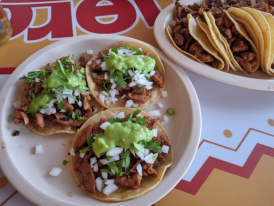
Tacos al pastor from El Güeros
El Güeros de Boturini (Venustiano Carranza)
This is where al pastor tacos become a midnight ritual. The auto shop transforms after dark.
I’ve dragged friends here at 11 PM, watching their skepticism vanish as trompo-sliced pork lands on fresh tortillas. The Mexican street food scene peaks late, and here pastor is less about spectacle and more about fueling hungry crowds under neon.
The trompo guy remembers I like extra pineapple and crispy edges. I always order gringas too, which is pastor with cheese grilled between flour tortilla.
Why here vs. the hyped neighbor: Los Güeros de Boturini beats tourist-packed Tizoncito with authentic atmosphere and no tour groups. Streets around Boturini fill with locals, busy and well lit until past midnight, making it one of the city’s true unofficial nightcaps.
El Huequito (Centro)
Al pastor benchmark alongside El Güeros de Boturini, widely respected for consistent quality.
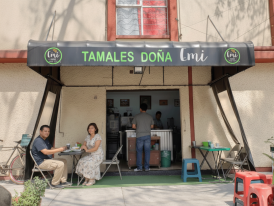
Tamales Doña Emi
Tamales
If you sleep past 8 AM, you've already missed tamale hour. That's just how it works here.
Cart Outside Metro Allende (Centro)
I've been buying from the same cart for three years now, the one that sets up right outside Metro Allende's Eje Central exit by 6 AM. Look for the vendor with the blue tarp and the tallest steam cloud on that corner.
She sells Oaxaqueños wrapped in banana leaves, and by now she knows I want extra salsa and always warns me when the chicken ones are running low. Her tamales sell out by 8 AM because office workers heading into Centro Histórico know exactly which cart to hit.
For something more structured, Doña Emi in Colonia Roma has become a tamal mecca with morning lines that form by 7 AM. She does verde, dulce, and rajas that locals swear by, and unlike the street carts, you can actually sit down with your coffee while you eat.
Forget hotel breakfast when visiting Mexico City. That's just not how you'll get a truly authentic street food or even basic Mexican food experience. Whether you hit the Metro Allende cart or wait in line at Doña Emi's, you're eating what chilangos eat before their day starts.
Timing: Get there by 7 AM or watch locals walk away disappointed. These sell out faster than concert tickets.
Coyoacán Plaza vVendors
Seasonal tamales, plaza ritual, morning lines.

Tlacoyo with nopales
Tlacoyos
Most tourists walk past comal ladies without realizing they're watching pre-Hispanic cooking techniques in action.
Blue Corn Comal Vendor Near Zamora and Montes de Oca (Condesa)
I've found a lady who sets up her comal, shaping blue corn masa into thick ovals, stuffing them with beans or requesón, then topping with nopales, salsa verde, and crumbled cheese. These ancestral masa pockets predate the Spanish by centuries, and watching her work feels like time travel. The corn tortilla base here isn't your standard supermarket version; it's earthy, substantial, designed to hold serious toppings. I always get mine with cooked cactus and extra green salsa. She laughs when I show up because she knows my order before I speak. She only works until noon, so adapt or miss out.
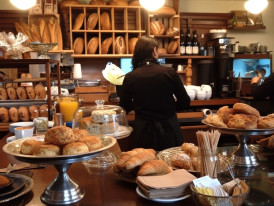
Panderia Rosetta
Pastries and Sweets
Mexico City takes its pastries as seriously as its tacos, which means showing up early or calling ahead isn't optional.
Panadería Rosetta (Roma Norte)
The guava roll at Rosetta sells out by 2 PM most days. I've learned to call ahead or face disappointment. This isn't your standard Mexican brunch pastry; it's French technique applied to Mexican flavors. While the sister restaurant Rosetta carries the fine dining accolades and Michelin star ambitions, the casual bakery counter is home to the signature guava roll with sweet guava and soft cheese in perfect balance. I made the mistake of showing up at 3 PM once, only to watch the last roll disappear into someone else's bag. Now I call at 10 AM to reserve mine. The staff recognizes my voice and sets one aside.
Why here vs. the hyped neighbor: Rosetta beats Instagrammable Lardo with consistent quality and no 90-minute waits if you call by 10 AM.
El Cardenal (Multiple Locations)
Abuela-approved breakfasts with pan dulce, nata, and frothy Mexican hot chocolate. Their huevos rancheros ride on crisped corn tortilla; simple and perfect. I think it's perfect for delicious lunch or substantial morning meals. Traditional Mexican cuisine since 1969.
This Isn't Just a Place on a List
Experience Roma Norte through hidden corners and stories most visitors miss.

Churreria El Moro
Churros and Hot Chocolate
The right churro-chocolate ratio is thick enough to coat the churro, not drown it.
Churrería El Tlacuache (Near Coyoacán)
Skip the tourist-trap Churrería El Moro queues in Centro. El Moro has multiple locations, but El Tlacuache serves better churros with less attitude. Hot oil, fresh dough, cinnamon sugar, and Mexican hot chocolate that tastes like chocolate instead of sugar water. The hot chocolate here comes thick enough to coat a spoon, made with real cacao and just enough sweetness. Dip your churros, don't dump them.
Why here vs. the hyped neighbor: El Tlacuache beats El Moro Centro queues with thicker chocolate and no 45-minute waits, especially weekday afternoons. If you want to eat churros right, this is where you come.
Churrería El Moro (Centro and Branches)
Since 1935, churro institution. Hit their smaller branches during off-peak hours to avoid the Centro spectacle.
Pozole and Sunday Traditions
If you don't understand pozole's place in Sunday culture, you're missing half the reason locals love weekends.
Neighborhood Pozolerias (Sundays Only)
Sundays mean pozole in neighborhood spots that only serve it once weekly. The hominy soup comes red or white, topped with lettuce, radishes, oregano, and lime juice. Families gather, conversations stretch, and hangovers heal over steaming bowls. This weekly ritual teaches you the city.

Mercado San Cosme
Barbacoa
Sunday mornings smell like lamb and consomé across half the city's markets.
Mercado San Cosme
Sundays before noon, I'm hunting barbacoa, that slow-cooked lamb that's been steaming in underground pits since Saturday night.
I feel that this isn't just a simple brunch; it's a weekly institution that anchors family gatherings across Mexico City. Arrive by 10 AM or risk finding empty pots and disappointed faces.
The vendors serve it by the taco or by weight, always with fresh tortillas, lime wedges, chopped onion and cilantro, and multiple salsas. Order the consomé first, that rich broth with garbanzos and chickpeas that serves as your appetizer and hangover cure.
Adventurous eaters ask for pancita (stomach lining) mixed into their tacos. I've spent countless Sunday mornings watching families claim tables, splitting kilos of barbacoa while kids run between stalls and conversations stretch until mid-afternoon.
It's the meal that reminds you Mexico City runs on ritual, not clock time, and food is never just food when it brings people together like this.
Tacos de Guisado
Lunchtime cazuela tacos are how office workers and students survive the afternoon without falling asleep at their desks.
Tacos Hola El Güero (Roma)
Long-running cazuela tacos with daily lunch rush, different tacos filled with daily stews from 1-4 PM.
Wanna Taste Real Tacos?
A local knows just where to find the best ones that they love themselves.

Fonda at the Mercado de Medellin. Photo by Karinadejesus via Wikicommons
Mercado Medellín Fondas (Roma Sur)
Variety-filled guisado stalls, cheaper than restaurants in Mexico City, serving what locals eat for comida corrida.
Chiles en Nogada (seasonal)
September cooking here tastes like independence celebrations, literally.
Various restaurants (September)
Those Instagram-famous poblanos stuffed with fruit and meat, draped in walnut cream and pomegranate seeds. The traditional Mexican cuisine dish tastes like Mexico's independence celebration. Time your first visit to taste holiday dishes at their peak.
Seasonal Specialties
November means pan de muerto floods every bakery. The orange-scented bread with bone-shaped decorations tastes better than it photographs, slightly sweet and perfect with Mexican hot chocolate.
December through January features romeritos (an herb served with mole sauce), buñuelos (fried pastry with syrup), and ponche navideño (warm fruit punch, sometimes spiked as a hot drink). Winter in Mexico City might not feel cold, but it tastes warm and spiced.
Tacos de Suadero
Suadero separates tourists from chilangos faster than any other taco style.
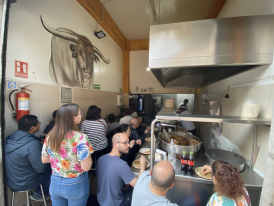
Taqueria el Torito
El Torito (Centro Histórico)
I come here when I need the most chilango taco experience possible. Suadero is supple beef that's been simmering in its own fat all day, then hit on the griddle for crispy edges. El Torito does it right, with the kind of turnover that means the meat never sits too long. The stand fills up after 9 PM with locals who know the griddle's properly seasoned by then.
Why here vs. the hyped neighbor: Doctores stays more authentic than gentrified Roma, and El Torito's been feeding the neighborhood for decades without needing Instagram fame.
Carnitas
Weekend carnitas require strategy because the best cuts disappear by early afternoon.
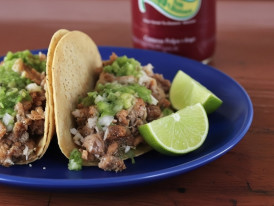
Tacos de carnitas from El Venadito
Carnitas El Venadito (Chimalistac/Coyoacán area)
Weekend lines form here by 11 AM because locals know the carnitas are still glistening from their lard bath. You order by the cut: maciza for lean meat, buche for stomach, surtida for the mix. I always get half a kilo surtida with extra cuerito (crispy skin) and watch them chop it fresh. By 2 PM, the best cuts are gone.
Tortas
If tacos are Mexico City's dinner, tortas are its rushed commute fuel.
La Texcocana (Centro)
This historic counter-only spot serves Mexico City's commuter sandwich culture at its fastest and most efficient. The bolillos are crusty, the fillings are generous (milanesa and pierna are classics), and you eat standing up like everyone else rushing to work or between errands. No seats, no ceremony, just fat sandwiches that fuel the city.
Mariscos CDMX-Style
Inland seafood sounds questionable until you realize the trucks from Veracruz arrive daily and locals have been perfecting this for generations.

Seafood tostadas from El Caguamo
El Caguamo (Centro Histórico)
Legendary seafood at an inland city stand. Their caldo de camarón arrives steaming with whole shrimp, and the cocteles come piled high with octopus, shrimp, and avocado. I go at lunch when the trucks from Veracruz have just delivered, and the place fills with office workers taking their midday break. This is how chilangos do seafood: fast, fresh, and without ocean views.
Guajolota + Atole
Nothing says "running late to work" like carbs wrapped in more carbs with a hot drink to wash it down.
Metro Exit Vendors Citywide
Pure chilango breakfast culture happens at metro exits from 6 to 9 AM, where vendors sell guajolotas (a tamal stuffed into a bolillo) with cups of hot atole. It sounds redundant until you try it rushing to work on a cold morning. The atole's usually champurrado (chocolate) or guayaba (guava), and the whole thing costs less than a fancy coffee while filling you until lunch.
Foodie Neighborhoods
I navigate this city by colonia food personalities, not by what the guidebooks recommend.
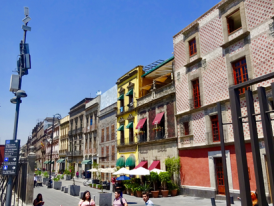
Street in Centro Historico
Centro Histórico
The historic center holds the city's drinking DNA and traditional Mexican cuisine heritage. Café de Tacuba serves since 1912, with tile walls and tortilla soup that showcases comfort food at its finest.
But for cantina culture, slip into Tío Pepe where locals argue politics over mezcal and complimentary botanas appear without asking. These appetizers could be simple snacks like peanuts or tortilla chips.

Cafes in Narvarte
Narvarte
This working-class neighborhood doesn't look Instagram-ready, but it owns Mexico City's best restaurants for late-night tacos and different tacos styles. El Vilsito transforms from auto shop to taco temple after dark. Lines form at 10 PM and the best tacos emerge from car repair chaos. If you're looking for fun things to do at night in Mexico City while eating well, this is for you.
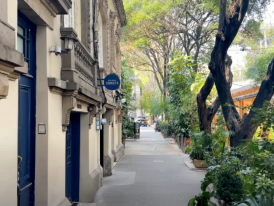
Sidewalk in Trendy Roma Norte
Roma Norte
Roma Norte mixes Michelin star ambitions with neighborhood charm. Rosetta bakes pastries that justify the hype. Pujol pushes Mexican ingredients into high-end food territory and fine dining reinvention. But don't skip the corner taquerias; gentrification hasn't killed all the good cheap stuff. Many galleries sit beside excellent Mexico City restaurants. I recommend you plan gallery walks that end with dinner at neighborhood favorites.

Colonia Condesa Cafe
Condesa
This is one of the city's densest zones for terraces. I like to duck off the main drags for tlacoyos and quesadillas made fresh on comales, especially at that blue corn griddle near Zamora and Montes de Oca.

Sidewalk in San Rafael
San Rafael neighborhood
San Rafael flies under tourist radar while serving some of the city's best food. Family-run fondas, Korean-Mexican fusion that works, and restaurants in Mexico City that locals guard jealously from guidebook fame. I've watched Korean families perfect their taco game while Korean restaurants serve kimchi that locals now consider comfort food.
Doctores
If you want true Mexican food, I suggest eating at Mercado Hidalgo for fondas and antojitos, then cool off at Paletería Maya (since 1974) for seasonal paletas like pan de muerto. Each neighborhood has distinct food rhythms that reflect local daily life and seasonal patterns.

Restaurant in Coyoacan
Coyoacán
Tamales plaza vendors, market tostadas, El Tlacuache churros, seasonal specialties.
Iztapalapa
Home to serious mercado culture at La Viga for seafood and Central de Abasto for wholesale-scale weekend barbacoa and carnitas.
Azcapotzalco
Traditional institutions like Nicos serve gold-standard seasonal preparations that earned their reputation decades ago.
Experiences Created by Locals, Just for You
See the city through the eyes of the people who call it home.
Nightlife and Bars
Mexico City at night offers more food than most cities' restaurants.
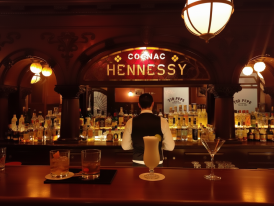
Cantina Tio Pepe
Cantina Tío Pepe (Centro)
Tío Pepe keeps old Mexico City cantina culture alive. Regulars and tourists share the room, the bar's all wood and patina, and rounds of botanas often appear alongside your drinks.
I spent my 30th birthday there with twelve friends. We ordered three rounds of mezcal and the botanas kept coming. By 11 PM, we'd eaten a full meal without ordering food. Go for the atmosphere; the specific delicious things on offer may vary by day.
Mezcalerías across colonias
Order mezcal, get small plates of chicharrón, cheese, and beans. The drinks flow, the conversation deepens, and you understand why Mexicans make drinking a social art.
Late-night pastor stands
After 10 PM, neon lights up trompos spinning across Narvarte and beyond. The city gets hungry, and the best tacos emerge.

Pulqueria Las Duelistas
Pulquería Las Duelistas (Centro)
Stop in for a curado (flavored pulque) before your late-night pastor run; the celery or oatmeal versions taste funkier than you expect, and the vibe is old Mexico City with wooden benches and regulars who've been drinking here for decades.
Imagine Experiencing This Side of Mexico City for Real
A local can show you the vibe, flavors, and hidden gems up close.
Authentic Food Markets
Markets teach you what locals actually buy and eat, not what tourists think they should photograph.

Fonda at Mercado Medellin
Mercado Medellín (Roma Sur)
I drag friends through Mercado Medellín on Saturday mornings, sampling tuna tostadas, fish tacos, tropical fruits, and whatever the fonda ladies recommend. This isn't a food tour; it's how locals shop and snack simultaneously. The fondas serve delicious things locals eat regularly, better Mexican food without the performance of San Juan's exotic spectacle.
Mercado San Cosme
Sunday barbacoa destination, vendors serving by 10 AM, consomé and lamb ritual.
Mercado Hidalgo (Doctores)
Fondas, antojitos, deeply local experience for food lovers who want authenticity.

La Merced fruit stand
La Merced
Massive market where bad food doesn't survive long, morning best (9 AM to 2 PM when crowds thin and vendors are relaxed).
Markets are generally well lit and easy to navigate. Vendors rely on repeat customers, so quality stays consistent.
La Viga and Central de Abasto
Go early (before 8 AM) for wholesale-scale produce culture and the kind of mercado energy that feeds the entire city.
Hidden Gems
These places don't advertise because word of mouth already fills their counters daily.
Expendio de Maíz Sin Nombre (Roma Norte)
With no sign and no menu, this is a unique place I always recommend. Worth the hunt for food lovers seeking the perfect dish.

Taqueria Selene
Taquería Selene (Anzures)
I order different tacos that showcase fusion. Their pastor recipe carries Lebanese DNA, but the execution is pure chilango.
Ramen Kazuki (Roma Norte)
Japanese ramen clusters bubble here. When my friends visiting from Puebla try the ramen, they don't call it foreign food. They call it delicious food.
Korean restaurants (San Rafael)
Korean barbecue hums, kimchi becomes comfort food, and Mexican food today includes flavors that arrived decades ago and took root so deep, locals claim them as heritage.
Tacos Don Chava (Roma)
Morning taco street stand excellence, best tacos for early risers.
Metro Allende tamales cart
Three-year relationship, extra salsa warnings, sells out by 8 AM. This is where food becomes friendship.
Read my Mexico City hidden gems guide to find the spots locals keep to themselves, where flavor and community matter more than fame.
Stereotypes and Reality
Half of what people believe about eating in Mexico City comes from travel blogs written by people who stayed three days in Roma Norte. Let me set the record straight.
All tacos all the time
Really, it's dawn tamales, late lunch fondas, 4 PM merienda, 10 PM+ pastor. The city's rhythm doesn't match tourist schedules.
Instagram bucket lists rule
Real eating syncs to eight million people's rhythm, not monuments. When locals queue at 10 PM for al pastor, there's a reason. When an abuela sells blue corn tlacoyos only until noon, you adapt or you miss out.
Hotel breakfast works
Misses 6 AM steam clouds and soul-deep masa satisfaction. That's just not how you'll get authentic street food or basic Mexican food.
Tourist-packed equals best
Tizoncito loses to El Güeros de Boturini's later hours and better atmosphere post-10 PM.
Churrería El Moro Centro
Massive queues, average churros. El Tlacuache wins with no 45-minute waits.
San Juan exotic spectacle
San Juan's exotic insects and unusual meats attract cameras but rarely repeat customers. Mercado Medellín serves what locals eat.
Cathedral rooftop restaurants
Fine dining prices, mediocre views. Cantinas offer mezcal with free botanas and conversations with strangers who become temporary friends.
Mexican street food is always risky
Not when you choose busy stalls with high turnover. Look for places packed with locals, fresh Mexican ingredients prepared in front of you, and vendors maintaining clean workspaces. I've eaten Mexican street food for eight years without major incident because I follow the crowds, not the guidebooks.
All Mexican cuisine is spicy
Plenty of dishes showcase Mexican ingredients without burning your taste buds. Start with a small dab of hot sauce first.
Street food is the only real food
Mexico City has world-class fine dining, historic institutions, and everything between. The beauty of what to eat in Mexico City isn't just variety; it's accessibility.
Go Beyond the Mexico City Checklist
Discover the city guidebooks don’t cover with a local by your side.
Overhyped → Local Alternatives
Some places earned their fame decades ago and now coast on reputation while better options feed the actual neighborhood.

Crickets in Mercado de San Juan
Keep: San Juan Market's Quality, Skip the Exotic Spectacle
Instead, hit Mercado Medellín for better Mexican food without the performance.
Tweak: Churrería El Moro Timing
El Moro in Centro draws massive queues for average churros. Hit their smaller branches during off-peak hours, or better yet, try El Tlacuache for superior churros with hot chocolate that doesn't taste like sweet milk.
Alternative: Neighborhood Cantinas Over Rooftop Bars
Skip cathedral rooftop restaurants charging fine dining prices for mediocre views. Cantina culture happens at Tío Pepe and similar spots where mezcal comes with free botanas.
Tizoncito → El Vilsito
Better pastor, later hours (post-10 PM), auto shop atmosphere, trompo guy who remembers preferences.
Lardo → Rosetta
Consistent quality, no 90-minute waits if you call by 10 AM for that guava roll.
Commercial food tour → Self-directed culinary adventure
Morning market graze, cantina lunch, midnight trompo. It beats a commercial tour because you set the pace and the plates. Food tour enthusiasts can create their own routes through Mexico City's neighborhoods.
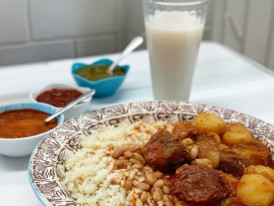
Comida Corrida (Set Lunch) from Las Flores
Everyday Rituals and Time-of-Day
The city eats on a schedule that tourists fight instead of following, which is why they end up disappointed.
6-8 AM: Dawn tamales
Steam clouds, Centro carts, office workers, masa hitting your nose at 6 AM pulls you to steaming tamales.
9 AM-2 PM: Market grazing
Crowds thin, vendors relaxed, best visiting window.
1-4 PM: Comida corrida
Fonda set lunch, cazuela tacos, late lunch culture. Mexico City pauses for proper midday meals, not grab-and-go.
4 PM: Merienda culture
4 PM hits and Mexico City pauses for merienda with hot chocolate, pan dulce, maybe churros. This isn't tourist theater; it's how locals break afternoon hunger while avoiding dinner at 6 PM like gringos.
After 10 PM: Pastor emerges
Trompos start spinning, lines form under neon, city gets hungry. The Mexican street food scene peaks when pastor becomes nightcap.
Past midnight: Peak taco hour
El Vilsito hits stride, al pastor tacos unite office workers and party-goers.
Sunday mornings: Barbacoa ritual
Before noon, families claim tables, arrive by 10 AM or find empty pots.
Sundays weekly: Pozole tradition
Hominy soup, conversations stretch, hangovers heal, families gather.
Saturday mornings: Market life
Mercado Medellín sampling, shopping and snacking simultaneously.
Now I plan by neighborhood and appetite, not monuments. The masa hits your nose at 6 AM, pulls you to steaming tamales in Centro, then to market fondas at lunch and cantina botanas by evening.
Seasonal Food Culture
Mexico City's calendar is marked by what's in season at markets and what abuela only makes once a year.
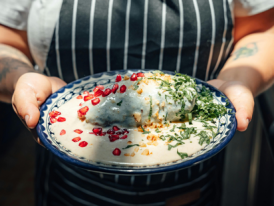
Chiles en Nogada
September: Independence flavors
Chiles en nogada season brings those Instagram-famous poblanos stuffed with fruit and meat, draped in walnut cream and pomegranate seeds from late August through September.

Pan de muerto altar
November: Day of the Dead bread
Pan de muerto floods every bakery with orange-scented bread and bone-shaped decorations, slightly sweet and perfect with Mexican hot chocolate.
December-January: Winter warmth
Romeritos (herb with mole sauce), buñuelos (fried pastry with syrup), ponche navideño (warm fruit punch). Winter might not feel cold, but it tastes warm and spiced.
Year-round timing rules
Blue corn tlacoyo lady works until noon only. Tamales carts peak by 8 AM. Pastor doesn't spin until 10 PM. Adapt or miss out.
Curious What You Won’t Find Online?
Discover the side only locals talk about.
Old vs New Identity
Eight years here means watching some vendors disappear while new ones prove they deserve to stay.
Old Mexico City Food
My trusted spots after eight years:
- Metro Allende tamale cart (three years running, she knows my extra salsa preference, warns about low chicken stock)
- El Vilsito trompo guy (remembers my extra pineapple and crispy edge requests)
- Condesa comal lady (knows my order before I speak, laughs when I show up)
- Rosetta staff (recognizes my voice on phone, sets aside guava roll at 10 AM calls)
- Café de Tacuba (serving since 1912, mole sauce represents generations of perfected recipes)
Traditional institutions:
- Cantina Tío Pepe (30th birthday with twelve friends, three mezcal rounds, botanas kept coming, ate full meal without ordering food)
- El Cardenal (since 1912, abuela-approved everything)
- Street vendors at metro exits (pure chilango culture)

Squash Blossom Taco from Expendio de Maíz Sin Nombre
New Mexico City Food
Modern reinterpretations:
- Pujol (Polanco) pushes Mexican ingredients into high-end territory
- Expendio de Maíz Sin Nombre (Roma Norte) with no sign, no menu, just trust
- Fusion working (Taquería Selene's Lebanese-chilango DNA, Korean-Mexican in San Rafael neighborhood)
- Ramen that Poblanos call delicious, not foreign
- Kimchi as comfort food for locals
What hasn't changed: Timing still rules everything. Eight years syncing appetite to this city's heartbeat. Learning that best restaurants in Mexico City aren't always restaurants and perfect dish isn't always on menus.
Etiquette and Local Rules
The unwritten rules separate people who eat well here from people who struggle through every transaction.
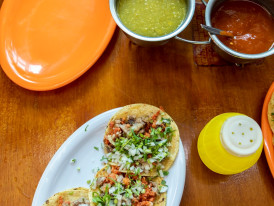
Tacos al pastor and a variety of salsas
Ordering and Etiquette
Quesadillas don't automatically include cheese here. I know, it sounds insane. Ask for "con queso" or you'll get masa folded around other fillings. This confused me for months until a vendor finally explained it. This is the Mexican version you need to understand.
Order tacos in small rounds, not all at once. I order three, eat them while they're hot, then order three more. The tortillas lose their warmth fast, and vendors respect the rhythm of continuous small orders over one massive plate that sits. Order at any taco stand this way.
Pay at the end unless the vendor says otherwise. Most taco stands and fondas let you accumulate your order and settle up when you're done. Keep mental count or ask "¿Cuánto llevo?" (How much do I have so far?).
Ask about salsa heat before drowning your taco. "¿Cuál pica más?" (Which one's hotter?) saves you from the molcajete of pure fire I once dumped on pastor. Start with a small test dab, especially with dark salsas that look innocent. Hot sauce tolerance varies.
Don't photograph vendors without asking. A quick "¿Puedo tomar una foto?" goes far. I've seen tourists get shut down for shooting without permission, and rightfully so.
Lines, Cash and Hygiene
Follow the locals' line, not the shortest one. If chilangos are queuing for 20 minutes at one trompo while another sits empty, there's a reason. Trust the crowd's judgment over convenience. This applies to every taco stand and street food operation.
Cash rules, and small bills make you everyone's favorite customer. Taco vendors rarely have change for 500-peso notes at 11 PM. I keep a pocket full of 20s and 50s. Breaking big bills at an OXXO before hitting the stands saves awkward waits. Coffee shops take cards, but street food runs on pesos.
Busy stalls with fast turnover are your safety filter. I choose places where meat's flying off the grill, tortillas are stacked high and disappearing, and locals are three-deep at the counter. Slow business means ingredients sitting too long. Steam means fresh. Lines mean locals approve. This is how you eat in Mexico City without stress.
Learn Mexico City's meal rhythm or miss the best stuff. Tamales peak 6-8 AM. Comida corrida (set lunch) runs 1-4 PM at fondas. Al pastor starts after 10 PM. Fighting this schedule means eating average versions at wrong hours. Food lovers who succeed think like locals: eat breakfast early, lunch late, dinner later.
Tipping culture: Not expected at street stands or market counters, but locals round up small bills (pay 25 pesos for a 22-peso order). At sit-down spots like Rosetta or cantinas, 10-15% is standard.
Useful phrases: "¿Qué me recomienda?" (What do you recommend?), "Con todo" (with everything), "¿Cuánto cuesta?" (How much does it cost?). These three phrases smooth every interaction. Spanish helps but isn't essential. Point at what looks good, smile at vendors, and trust the process. Mexican ingredients and techniques speak universal deliciousness even when words fail.

Market food stand in Coyoacan
Interest-Based Eating
Whether you're here for art, street buzz, or unique things to do in Mexico City, I plan every suggestion around what we'll eat next. I try to make sure every interest connects to distinct food cultures that enhance the experience.
Arts and Culture Enthusiasts should time museum visits around nearby food traditions. Many galleries in Roma Norte sit beside excellent restaurants in Mexico City.
Street Life and Market Lovers will find paradise in traditional mercados. Start early at Mercado de Medellín for breakfast, then work through different colonias' markets. Each has distinct specialties.
Nightlife Seekers will discover that Mexico City's best late-night scenes include a lot of food. Start with dinner at neighborhood cantinas, then migrate to late-night street food stands serving different tacos until 4 AM.
Food Tour Enthusiasts can create their own culinary adventure through neighborhoods. Morning market graze, easy cantina lunch, midnight trompo. It beats a commercial tour because you set the pace and the plates.
Global Food Scene
Mexican food today includes flavors that arrived decades ago and took root so deep, locals claim them as heritage. Lebanese technique shapes al pastor. Japanese ramen clusters bubble in Roma Norte. Korean barbecue hums near Chapultepec. This isn't fusion for fusion's sake; it's immigration creating new traditions.
At Taquería Selene in Anzures, I order different tacos that showcase this fusion. In San Rafael neighborhood, I've watched Korean families perfect their taco game. This is how food cultures evolve in real time. If you're planning day trips in Mexico City, these spots are ideal for a memorable time.
Before You Go, Talk to Someone Who Knows
A local video call helps you plan the trip that’s right for you.
Frequently Asked Questions
1) Where can I find the best tacos in Mexico City?
The best tacos in Mexico City depend on timing and style. For al pastor: El Huequito in Centro or El Güeros de Boturini in Venustiano Carranza. For morning tacos: Don Chava's placeros in Roma. Each neighborhood has excellent options.
2) How much should I budget for eating well here?
Street tacos run 20-35 MXN each, market fondas serve full meals for 100-160 pesos, and Rosetta-level spots cost 300-500 pesos per person, sometimes a bit more. Budget 800-1,500 pesos daily for three solid meals mixing street and sit-down spots.
3) Do I need to tip at taco stands and markets?
Not expected at street stands or market counters, but locals round up small bills (pay 25 pesos for a 22-peso order). At sit-down spots like Rosetta or cantinas, 10-15% is standard.
4) What if I don't speak Spanish well?
Learn "¿Qué me recomienda?" (What do you recommend?) and "Con todo" (with everything). Point at the trompo, smile at the tortilla lady, hold up fingers for quantity. Food vendors are patient with enthusiastic eaters who try.
5) What should I eat beyond tacos for a complete Mexican food guide experience?
Choices for food and drink in Mexico City are vast. Try tlacoyos, quesadillas made fresh on comales, pozole soup, tamales, and regional specialties like mole sauce. Don't miss agua fresca drinks and seasonal treats like corn smut (huitlacoche) preparations.
6) Is Mexican street food safe for a first visit?
Yes, when you choose busy stalls with high turnover. Look for places packed with locals, fresh Mexican ingredients prepared in front of you, and vendors maintaining clean workspaces.
7) What are some unique Mexican version dishes I should try?
Look for tuna tostadas, tlacoyos with hoja santa, dishes featuring pomegranate seeds in season, and the Mexican version of dulce de leche called cajeta. Many traditional preparations use Mexican ingredients in ways you won't find elsewhere.
8) Where can I find restaurants in Mexico City with skirt steak?
Many traditional cantinas serve carne asada (grilled skirt steak) alongside other classic dishes. Look for neighborhood places that specialize in grilled meats rather than tourist-focused establishments.
9) Should I take a food tour or explore independently?
Independent exploration offers more flexibility and authentic experiences. Create your own food tour by visiting morning markets, afternoon cantinas, and evening street vendors across different neighborhoods.
10) What drinks pair well with Mexican cuisine?
Try agua fresca (fresh fruit waters), traditional pulque, or mezcal. Many dishes pair beautifully with these Mexican beverages, especially spicy foods that benefit from cooling drinks.

Quesadillas, flautas and gorditas
Final Thoughts
I've mapped this city by taste, learning that what to eat in Mexico City isn't centered on bucket lists; it's focused on syncing your hunger to eight million people's daily rhythm.
Al pastor tacos, green salsa, cooked cactus, some of the best food you can eat, and when you eat like locals eat, you're participating in daily culture that defines how eight million people live and connect.
I've spent eight years syncing my appetite to this city's heartbeat, learning that the best restaurants in Mexico City aren't always restaurants and the perfect dish isn't always on menus. Sometimes it's a tlacoyo from a comal in Condesa, sometimes it's late-night pastor in Narvarte, always it's about timing and trust.
Now you're all set for an amazing Mexico experience. Don't hesitate, my city is waiting.
More of Mexico City
Ready to plan your perfect day in Mexico City?
Start your experienceTravel Guides Can Only Take You So Far
City Unscripted pairs you with someone who lives there, so you can see iconic sights and hidden corners in a way that feels like yours.
Wish you had a local friend in Mexico City?
One who knows the city inside out and could plan a private day just for you? Our local hosts do exactly that: no scripts, no tourist traps, just the side of the city most people miss.




